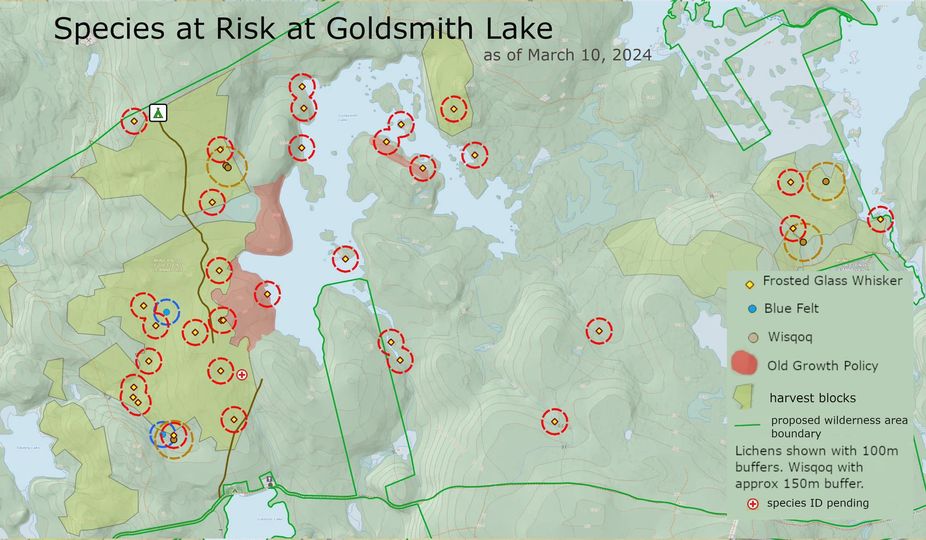For related pages, see Goldsmith Lake Forests & subpages listed there.
——–
“Camp” has started again, this time at Goldsmith Lake Wilderness Area.
Related posts on the Friends of Goldsmith Lake Wilderness Area Facebook page are copied here with permission as a single record//to help make them more widely available. They are posted in reverse chronological order (most recent at top). Go to the first one as an intro.
Also view: Ashlea Hegedus-Viola on Stubble Lichens (Apr 9, 2024)
Lichen Camp Day 77
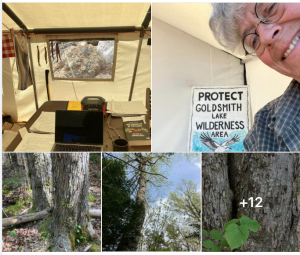 Nina Newington, May 17, 2024.
Nina Newington, May 17, 2024.
Yesterday began with a hermit thrush singing at dawn. It ended with loons calling in the night. That’s a good day right there but that wasn’t all by any means.
For those of us who spend a fair bit of time at camp, life settles into a rhythm. In the morning I worked on updating the proposal
we submitted back in November 2022
to protect the Goldsmith Lake Wilderness Area. It’s amazing how much we have learned since then.
An area that WestFor dismissed as having all been cut over and not worth protecting now has multiple stands of old growth forest recognized by DNRR. To start with we had documented only two species at risk occurrences. Now we are at 62.
The thing is, with Lichen Camp as a base, we keep discovering more.
In the afternoon I went to check out an area southwest of camp just to see what was there. The topography looked interesting on the map, but before I reached my destination I saw very tall trees to either side of the old logging road I was on. Growing on the slopes along a tiny stream were huge sugar maples, white ash, yellow birch, beech, even some big red spruce. The trunks were columnar not tapered, the branches high up, sparse, mostly at right angles to the trunk. The forest floor was covered in fallen trunks and limbs — coarse woody debris it’s called. It’s one of the things DNRR counts in assessing old growth, the amount of coarse woody debris over 20cm in diameter in their sample plots.
The slopes were mostly too rocky to really show the classic pit and mound pattern on the forest floor but there was one area where it was easy to pick out. Hobblebush grew in many spots. It showed signs of deer browse but it was there. There were no signs of any cutting having been done.
Walking upstream, in a few hundred metres, while old hardwoods had been left, there were many large mossed over stumps. These had probably been the red spruce Bowater prized but at least they didn’t take everything and, in the lower reaches of that gully, they left the forest completely alone.
That stand of old growth is probably too small for DNRR to assess but there is no doubt in my mind that’s what it is. A pocket of ancient forest, a tiny reservoir of biodiversity. A place to stand and breathe and take in the wholeness — until the black flies grew too thick.
Back at camp, two lichen hunters showed up as it began to rain. We cooked supper and talked about — what else? — lichens and forests and protecting forests. We ate good food and laughed and went our ways. Well, I stayed. They went their ways. Just another grand day at Lichen Camp.
Lichen Camp Day 75
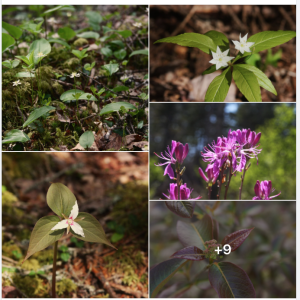 Ashlea Viola, May 15, 2024.
Ashlea Viola, May 15, 2024.
Spring Wildflowers
This time of the year always seems to be bursting with life – trees budding and blooming, ferns unfurling, and the “green-up” of the forest floor amidst so much buzzing and peeping and chirping. One of the interesting things about lichens is that we can see most of them year-round. But the trees and trilliums only bloom for so long. Of course, there’s a joy in that, too. Right now, red maple flowers are falling on top of leaves and moss and it’s hard not to mistake them for something else. Getting to know the ephemeral flowers is another way of “reading” the forest. And there sure is a lot to read in late spring and early summer!
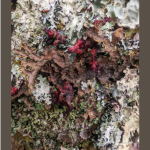 Lichen Camp Day 72
Lichen Camp Day 72
Nina Newington, May 12, 2024
Happy Mother’s Day to our beloved Earth!
Lichen Camp Day 70
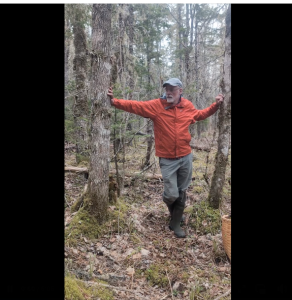 Ashlea Viola on May 9, 2024
Ashlea Viola on May 9, 2024
Learning how to recognize wisqoq
Wisqoq, in Mi’kmaq, is a native swampy woodland tree. It’s also known as black ash; swamp ash; basket ash; hoop ash; water ash; or Fraxinus nigra, botanically. In 2013 wisqoq was listed as threatened in Nova Scotia’s Endangered Species Act. Several wisqoq have been reported to DNRR from the Goldsmith Lake area, within or near harvest blocks. This one, not far from lichen camp, is growing next to a similarly-sized white ash. Listen as Jonathan explains some of the differences between the two trees and how to identify wisqoq, even before the leaves are out.
Discussion of Past Cutting
Nina Newington Post on May 9, 2020:
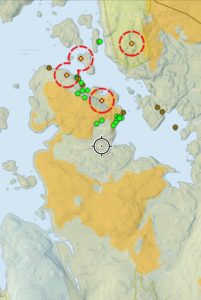 The ochre shows the areas DNRR identified as potential ‘High Production Forestry’ sites before citizen scientists discovered a 4 hectare stand of old-growth hardwood forest as well as many large old hemlocks with coral lichen growing on them (the green dots.) Coral lichen is the only lichen DNRR recognizes as an old growth indicator species in their protocol for identifying old growth forest. DNRR appear to have been relying on Bowater maps which show this peninsula having been clearcut in 1971-2. One of the smaller hemlocks came in at 276 years old, based on a core sample we took.
The ochre shows the areas DNRR identified as potential ‘High Production Forestry’ sites before citizen scientists discovered a 4 hectare stand of old-growth hardwood forest as well as many large old hemlocks with coral lichen growing on them (the green dots.) Coral lichen is the only lichen DNRR recognizes as an old growth indicator species in their protocol for identifying old growth forest. DNRR appear to have been relying on Bowater maps which show this peninsula having been clearcut in 1971-2. One of the smaller hemlocks came in at 276 years old, based on a core sample we took.
The yellow diamonds with red buffers are species at risk Frosted Glass Whiskers lichens.
Comments
DGP: Bowater didn’t just sweep the landscape, they left many patches of older forest
NN to DGP:That’s true. That’s why we have found so many Frosted Glass Whiskers lichens. It is shocking to realize that the clearcutting became more ruthless, not less, after Nova Scotians bought back these lands from Bowater. That’s thanks to WestFor and DNRR.
DK: And I thought DNRR’s job was to protect our beautiful forests! Silly me, they are giving away the resources to the ones who want to destroy the forests for short term gain. They should be called the Dept of Neglect and Robbery of Resources
DGP: Here are some comments related to the Bowater-St. Margaret’s Bay Lands: “Some of the elders in our two naturalist societies have been visiting this area for close to 50 years. One member comments that Bowater was overall a good forest manager; they cut on relatively long rotations, some of it selective logging, and left many areas with old trees or other special ecological features untouched. He goes on to state that under WestFor management he has noted the logging of younger forests with very little left untouched and that the area being logged and new roads are increasing at a seemingly furious pace in the last few years as compared to the years under Bowater management…When I went on these lands twenty or so years ago, I would consistently see 5 or 6 deer, 4 or 5 red-tailed hawks, a barred owl or two, lots of nighthawks and many warblers…today I often see nothing, not even a porcupine. I have heard barred owls but I have not seen one in years. – Naturalist”. From this post on NSFN
Comments submitted to PPA Consultation with a focus on the Ingram River Conservation Area 27 Sep 2021
NN to DGP:That tallies with what Perry Monroe, perhaps the last of the old time guides, had to say when he came to Last Hope. Bowater recognized that the Beal’s Brook area was ‘moose country, not lumber country.’ In 2000 when Randy Neily asked Bowater not to cut the forest we ended up protecting with the Last Hope Camp because it was so important to wildlife, they agreed. Twenty years later WestFor flatly refused the same request. So did DNRR, claiming they had reviewed the area not once but twice for species at risk. ‘Nothing to see here, move along now.’ It took people camping out to keep the forest standing long enough for citizen scientists to identify 17 species at risk occurrences in that one cutblock.
Lichen Camp Day 69
Nina Newington on May 9, 2024
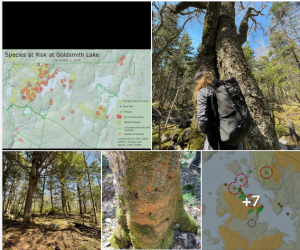 The other day two citizen scientists decided to check out the intriguing little patch of DNRR-recognized Old Growth Forest just beyond the southernmost edge of the proposed Goldsmith Lake Wilderness Area. It’s a skinny strip of red on the map, now with 5 possible Frosted Glass Whiskers occurrences (pending confirmation).
The other day two citizen scientists decided to check out the intriguing little patch of DNRR-recognized Old Growth Forest just beyond the southernmost edge of the proposed Goldsmith Lake Wilderness Area. It’s a skinny strip of red on the map, now with 5 possible Frosted Glass Whiskers occurrences (pending confirmation).
Here’s what one of them had to say: ‘Pretty tiny thin stretch of OGF surrounded by clearcuts or what amount to clearcuts — great that they set this tiny strip aside – but it shows their lack of landscape level planning – what hope does this thin stretch have — surrounded by clearcuts – blow down, reduced humidity, invasive vectors??’
Exactly the same fate would befall the 4 hectare slope of old growth hardwood forest we discovered on the peninsula at Goldsmith last summer, if DNRR had their way. Their ‘High Production Forestry’ maps still identify most of that peninsula as a potential site for clearcutting and spraying. They did back the ‘High Production Forestry’ boundary off by 100m after their team found that the hardwood slope met their criteria for Old Growth Forest. But that’s it.
This is ridiculous. Any old growth and near old growth forest still left standing in this province is precious. It needs real protection.
Good thing citizen scientists are doing the footwork to demonstrate just how ecologically important the Goldsmith Lake Wilderness Area is.
Good thing this government has committed to protecting 15% of the province by March 2026, and 20% by 2030.
—–
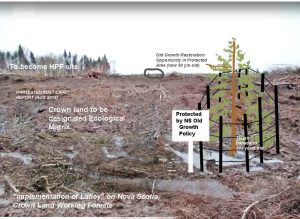 Comments: DGP: Unfort DNRtoNRR looks at Old Growth like an animal in a zoo…See Post
Comments: DGP: Unfort DNRtoNRR looks at Old Growth like an animal in a zoo…See Post
NN to DGP: It does look that way. Within already protected areas DNRR are quite ready to declare areas surrounding old growth forest ‘old growth forest restoration areas’ which puts them off limits for logging. But out where logging is actually a possibility they seem much less inclined to surround old growth patches with old growth restoration areas. Why ever not? Other than the obvious explanation that it would annoy industrial forestry, it’s hard to see why they wouldn’t use the tools the Old Growth Forest Policy makes available to help restore the ecosystem health of more of our forests. After all, that is Lahey’s overarching recommendation…
Lichen Camp Day 65
Ashlea Viola, May 6, 2024
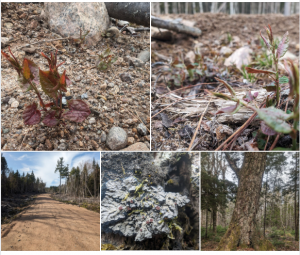 The Trouble with Logging Roads (Part 2)
The Trouble with Logging Roads (Part 2)
Lichen camp sits at the north end of a 30m-wide, 2km-long logging road. Back on day 22 of lichen camp, Nina wrote about the giant wind tunnel effect of the road and how this clearcut isn’t counted in the overall calculation for how much forest is removed from each of the three harvest plan areas that the road passes through.
Today, walking away from camp along the logging road, about 3/4s of the way down, with the old-growth designated area to the east and several species-at-risk lichens to the west, I stopped suddenly. Along the edge of the road, young shoots of knotweed were sprouting up through the gravel. This is a hugely invasive plant that will grow in thick clumps, eventually shading out the plants around it. Knotweed thrives in open, exposed sites but can also grow in deep shade.
The practice of stockpiling gravel for roadbuilding can lead to the introduction and wide distribution of plants into new environments. (It’s how coltsfoot was sown all along the roads of Gros Morne National Park, for example.) As I stepped off the gravel into the mess of stumps and brush at the edge of the logging road, I couldn’t help imagining how knotweed could colonize parts of the forest here. What will this forest look like down the road? What could this forest have looked like without a huge swath of road chopping it apart? And how many other invasive plants will take root from logging road contruction practices?
 Lichen Camp Day 63
Lichen Camp Day 63
Nina Newington on May 3, 2024
Bird food (aka black flies) drew first blood yesterday afternoon. We might soon be glad of the wind that blasts up the abominable new logging road.
Yesterday’s ramble in woods west of camp revealed that not all had been clearcut 50 years ago. Little patches of old yellow birch, red spruce, white pine and red maple bear witness to the forest that was once here — and can be again.
The little streams run clear with the sort of gravel bottoms trout like to spawn in. In the heartwood of an old red maple by one of these streams grew a mini-forest of a yellow-green stubble lichen called Chaenotheca brachypoda. Like the Frosted Glass Whiskers lichen, it is late successional meaning it grows in old forest. In this case it is in a tiny remnant of old forest that is still sheltered and humid enough for it to thrive. Unlike the Frosted Glass Whiskers, it is not listed as at risk and wouldn’t get a 100m buffer.
This area of forest has been identified by DNRR for potential high production forestry meaning clearcutting and spraying. That won’t happen if the Goldsmith Lake Wilderness Area is granted permanent protection. Instead the richness of life – the biodiversity – that thrives in the extensive old growth forest along the west side of the lake will, over time, expand into forests like the one right around camp, forests recovering from a bad dream of 20th century forest ‘management’.
 Lichen Camp Day 60
Lichen Camp Day 60
Nina Newington on April 30, 2024
Sixty days since we set up our forest protection and education camp!
So many people have stepped up, all of us working toward getting permanent protection for the Goldsmith Lake Wilderness Area. All of us are doing what we can, whether it is camping or scheduling or lichen hunting or organising supplies, writing letters to ministers, bringing firewood, donating money, camp-sitting in the day, welcoming visitors. The list goes on. What is wonderful is the mix of steadfast commitment from people involved since the beginning and the great array of new people getting involved.
What we are saying, all of us in our own ways, is ‘It’s not too late.’ It’s not too late to save the forests around Goldsmith Lake. It’s not too late to change the way we treat the Earth (and that includes ourselves.) Together we can do this.
 Lichen Camp Day 57
Lichen Camp Day 57
Nina Newington Apr 27, 2024
Sunny crisp mornings at camp might begin with firing up the woodstove to make coffee, then retreating to bag to sip and listen to the birds. A true birder would be up and out at dawn but Merlin records quite well through canvas walls!
The Hermit thrush sings first right around dawn, followed by the yellow-rumped warbler. Yesterday a loon flew up from the south, calling all the way. Last year, kayaking on the lake, we counted 9 ‘bachelor’ loons hanging out.
For those of us who are not expert birders, Merlin has been a revelation. Some people remember sequences of sound well. If you don’t, seeing the pattern of a bird’s song is helpful. Plus the sonograms are beautiful.
In Britain, meticulous bird lists made by amateur naturalists provide an invaluable record of the dates of first arrivals going back over 200 years. Renamed citizen scientists, and helped now by smart phones and free apps, people who care about our natural world enough to pay close attention are still collecting important data.
It is painful to witness the impacts of climate change and ruthless resource extraction on the gorgeous complexity of our world. But working for and with nature, we are, as one friend put it, ‘batting for the big team.’ And deep attention brings deep joy. That’s the secret sauce at Lichen Camp.
#lichencamp #citizenscience
 #LichenCamp Day 55
#LichenCamp Day 55
Haeweon Ti, Apr 25, 2024
🌕| We gathered on the logging road. We will be scattered by the wind and washed away by the rain. But we will constantly come back together to keep the life of the forest in a cycle. We will decompose our grief to reconnect this circle again and again.
(Please feel free to add on to these circles of life 🙂 — all created with the found materials on the forest floor near the camp)
 Lichen Camp Day 54
Lichen Camp Day 54
Nina Newington, Apr 24, 2024
What a joy to wake to the song of a Hermit thrush, Barred owl hoo-hooing in the distance. Yesterday toward dusk we walked in the forest just east of camp with Shalan Joudry and her daughter and friend, pausing to listen to Golden-crowned kinglets and a Winter wren.
We spoke of the Canada jays that we’ve heard regularly in the older forest south of camp. Shalan laughed, hearing that two showed up for lunch on a February lichen foray. Nikjako’kej is their Mi’kmaw name but they have another name too that translates as ‘the beggar.’ The English nickname, Whiskey jack, is from the Cree name for the bird, Wisakedjak, which means ‘the trickster’. Shalan used to hear these birds in Bear River but no more.
It feels good to be here, protecting the homes of these birds, learning more from the traditional guardians of these land
 Lichen Camp Day 51
Lichen Camp Day 51
Nina Newington, Apr 21, 2024
It takes a lot of people and plenty of coffee to keep a camp going for 51 days and counting. Whether it’s a sunny day on the South Mountain or a cloudy day on the Halifax waterfront, from Lichen Camp to the People’s Parade for Life on Earth, what connects us all is care. Care for the Earth and each other. Msit nokoma. All our relations.
Lichen Camp Day 48
Nina Newington, Apr 18, 2024
Loons yodel night-wide,
Junco greets the day, overhead
Crow feathers rubbing
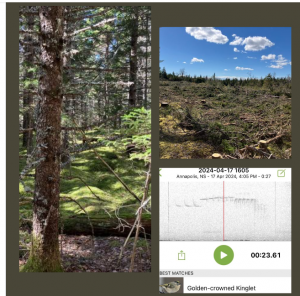 Inspired by ace lichen hunter Jonathan Riley, haiku makes its way into camp
Inspired by ace lichen hunter Jonathan Riley, haiku makes its way into camp
life. An ancient Japanese form of poetry, haikus generally focus on nature.
Going to sleep to tree frogs and waking to birdsong is magical. But this morning by far the loudest sound at camp is traffic on the 101. That’s mostly because – for once – there is no wind. The usual direction of the wind carries the noise away from camp. A year ago, though, even on still days, we would scarcely notice the noise. We weren’t camped out 24/7 then, it’s true, but something else has changed.
On private land just to the northeast of camp there used to be dense forest. Now it is gone, clearcut this past winter. The sound travels unimpeded.
The way forests absorb noise isn’t often at the top of the list of ways humans benefit from forests but it is important. The double whammy of losing natural soundscapes and increasing noise pollution is bad for our health, mental and physical. Not to mention its impacts on all the other life forms we share this planet with.
The way things are, there’s not a lot we can do about clearcutting on private land. Groups like the Nova Scotia Working Woodland Trust and Dale Prest’s Growing Forests are developing long term options, and organizations like the Nova Scotia Woodland Owners and Operators are encouraging better practices. What we can change now is what happens to our public lands. The spot where we are camped has been identified by DNRR as a potential site for clearcutting and spraying. That won’t happen if we can persuade the government to protect the Goldsmith Lake Wilderness Area.
Please write to the Minister of Environment and Climate Change encouraging him to include the Goldsmith Lake Wilderness Area in the next tranche of crown land to be protected. And ask him to extend interim protection to the area right away. Minister.environment@novascotia.ca
Lichen Camp Day 45
Nina Newington, Apr 15, 2024
 Guess what?! An article by citizen scientists working to protect Goldsmith Lake is being published in a peer-reviewed scientific journal. ‘Bursting the stubble bubble: citizen scientists measure ecological continuity near
Guess what?! An article by citizen scientists working to protect Goldsmith Lake is being published in a peer-reviewed scientific journal. ‘Bursting the stubble bubble: citizen scientists measure ecological continuity near
Goldsmith Lake, Nova Scotia using calicioid lichens and fungi’ by Ashlea Viola, Nina Newington, Jonathan Riley, Steven Selva and Lisa Proulx will appear this spring in Evansia, vol. 41, issue 1.
Frosted Glass Whiskers is just one of the Calicioid (stubble) lichens we have found at Goldsmith. It is the only one that is granted the protection of a 100m buffer. There are

Abstract of article that will appear in Evansia
others that only show up in ‘late successional’ (old) forests as well. They tend to be rarer than ones that can live in younger forests, for obvious reasons. Without going into detail, North America’s Calicioid lichen expert, Dr. Steven Selva, proposes that finding more than 20 different species of stubble lichens in a forest indicates that that forest has the ecological continuity typical of very old forest and is therefore of high conservation value. We identified 27 different species in mixed forest west of Goldsmith Lake! That includes one species never before reported in Nova Scotia.
…and the full Poster!!:
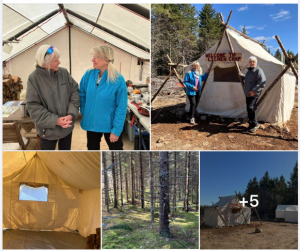 Lichen Camp Day 42
Lichen Camp Day 42
Nina Newington, Apr 12, 2024
Well, the sunshine was welcome while it lasted. There’s a special quality to the light in a canvas tent when the sun is out. But, whatever the weather, it feels good to be at Lichen Camp, looking around at forest that would by now be logged if it weren’t for your dedication.
The wind blasting up the road again is a reminder of how much worse it would be for all the inhabitants of the forest if the cuts approved by DNRR had gone ahead — cuts which claim to be ‘ecological’ even though they would remove at least 50% of the trees.
Thanks to the campers and lichen hunters, the dancers, painters, musicians, soup makers and bakers, email senders and schedulers, letter writers and poster makers, the forests around Goldsmith Lake are still standing. One day they will have permanent protection as the Goldsmith Lake Wilderness Area. For now, they depend on us. Contact lichencamp@gmail.com if you want to help.
Lichen Camp Day 40
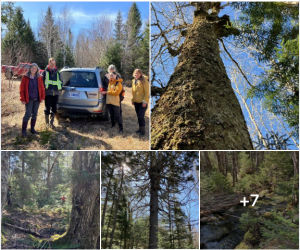 Nina Newington, Apr 10, 2024
Nina Newington, Apr 10, 2024
Monday’s foray into a part of the proposed Goldsmith Lake Wilderness Area we hadn’t visited before took us into more beautiful old forest with big yellow Birch and — unusually — Red Spruce with diameters at breast height of 58cm and 66cm.
We found at least two species of late successional stubble lichens, including two Sclerophora. Whether these were the Frosted Glass Whiskers or her unprotected but if anything even rarer cousin we won’t know for a few days.
What we do know is that this whole area continues to surprise and delight us. Even though parts of it have been ravaged by past forestry practices, it has what it needs to heal if it is allowed to do so.
Lichen Camp Day 38
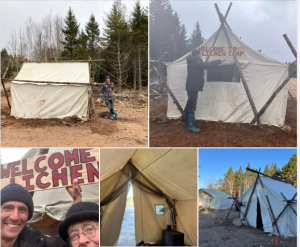 Nina Newington, Apr 8, 2024
Nina Newington, Apr 8, 2024
After the wind dropped and the snow melted off, it was time to go back to putting up the second, smaller prospectors tent. This one has an exterior frame made of poles and rope. The first effort failed in another windstorm a couple of weeks ago. Lessons were learned, new strategies developed. It’s a good testing ground, the head of this logging road. So we shall see. One thing we have in abundance is tenacity. Some might have other words for it.
Today looks like a great day to go lichen hunting in another enticing spot in the amazing Goldsmith Lake Wilderness Area (proposed Wilderness Area, that is.) To be followed by some partial eclipse watching. Life is good.
Lichen Camp Day 35
Nina Newington on Apr 5, 2024
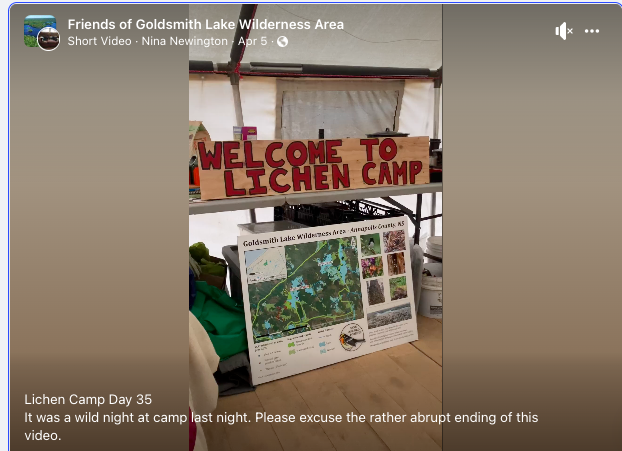
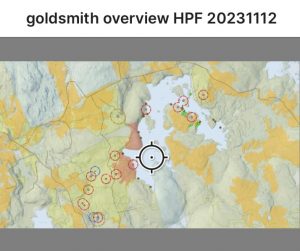
The yellow patches on this map [at right] have been identified by DNRR as potential sites for clearcutting and spraying.
Nina Newington on Apr 3, 2024
Goldsmith Lake is a rare, unspoiled lake where speckled trout still thrive. Here’s what DNRR has in mind for it, if we don’t get this area protected. The yellow patches on this map [at right] have been identified by DNRR as potential sites for clearcutting and spraying. The green patches have already been approved for ‘ecological’ forestry, meaning the removal of 50% of the trees.
Just look at where DNRR thinks it would be appropriate to clearcut. Right down to the boat landing at the north end of the lake. On the peninsula where we identified old-growth. Those green dots are big old hemlocks. DNRR have since scaled the clearcut sites back very slightly around the now officially recognized old-growth but these supposedly ‘High Production Forestry’ sites still reach from lake shore to lake shore across the peninsula. They leave a buffer of 20 whole meters between the clearcut and lake edge.
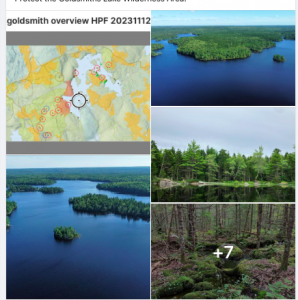 Then there are all the little streams that meander through the proposed clearcuts into the lake. Listen again to what long-time resident Richard Fox has to say in our Day 31 post about the effects of any future logging around Goldsmith Lake on the trout that still thrive there.
Then there are all the little streams that meander through the proposed clearcuts into the lake. Listen again to what long-time resident Richard Fox has to say in our Day 31 post about the effects of any future logging around Goldsmith Lake on the trout that still thrive there.Thanks to the citizen scientists who identified all the species at risk occurrences shown with their buffer zones, DNRR quietly reduced the green ‘ecological’ harvest areas by 40% in November. That was good. But also misleading. The Minister’s PR team assures the public there will be no clearcutting around Goldsmith Lake. They fail to add one critical word. Yet.
Protect the Goldsmiths Lake Wilderness Area!
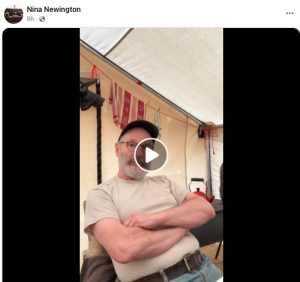 Lichen Camp Day 31
Lichen Camp Day 31
Richard Fox stopped by camp the other day. He has lived most of his 70+ years on the Morse Rd. As a teenager he fished in Corbett and Goldsmith Lakes. ‘The streams that flowed from those lakes, the trout seemed boundless to my innocent eyes.’ But then Bloody Creek was dammed and a canal was cut from Corbett to the newly created Dalhousie Lake. The last trout was caught in Corbett Lake in 1988. Fortunately Goldsmith Lake is different…
Lichen Camp Day 29
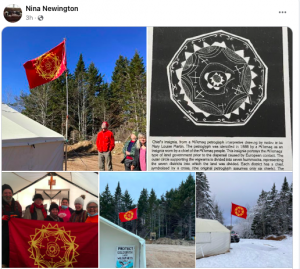 Nina Newington, Mar 30, 2024
Nina Newington, Mar 30, 2024
Marilynn-Leigh Francis, District Chief of the 1st Original District Kespukwitk Overseer’s Tribal Council, presented this flag to the Last Hope camp on January 21st, 2022. It flew there until the camp declared a win six months later. The District Chief has given permission for the flag to be flown at Lichen Camp and was planning to visit but the roads turned to soup. We are looking forward to welcoming her to our forest protection and education camp.
The flag design is taken from a petroglyph. It represents the seven traditional districts of Mi’kma’ki, of which Kespukwitk is the first. It is an honour and a reminder, to see this flag flying over camp.
Gary Metallic Sr, the District Chief of 7th District Gespegawagi (Gaspe peninsula) of Mi’kma’ki commented on our January 22nd, 2022, post about the District Chief’s visit to the Last Hope Camp on the Peace and Friendship Alliance Facebook group. He gave us permission to copy his comment:
It warms my heart to see the 1st District Kespukwitk District Chief Marilyn Leigh Francis and her family and allies at your protection camp. Their visit is not to only be seen as a symbolic visit within their still Unceded 1st District homelands, but their presence at your protection camp means that you as the non Mi’gmaq allies protectors are there by their invitation which the N.S. Provincial government cannot label you as trespassers.
Further it is their 1st Districts Original kespukwitk’s governing systems recognition of your commitment and sacrifices made for the protection of all the wildlife, fauna and waters in their Unceded Ancestral District territory.
We the 7th District Gespegawagi Overseers Tribal governing system formed a similar alliance back in 2017 with the Quebec environmentalist who had also setup their Protectors River camp in our Gespégawagi traditional territory to stop an oil and gas company from drilling for oil near a salmon river. The Quebec govt tried to charge them for trespassing and dismantle their camp, they asked our 7th District Tribal council to write a letter to the Quebec govt that they were there at our invitation within our still Unceded 7th District homelands.
Once that letter was sent to the Quebec govt they stopped their threats to dismantle the environmental protectors camp because they didn’t want an Aboriginal title case in the Quebec Superior court. Nice to see the Original Seven Districts Nation flag, find a high pole to tie it to, that flag that will fly at that camp affirms that it is on still Unceded Mi’kmaq lands, Welalieg.
Mar 25, 2024
🎂Happy Birthday to SOOF!🎂
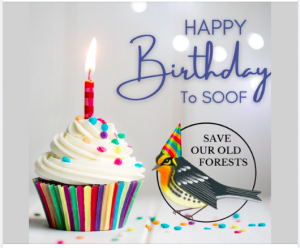 The Save Our Old Forests (SOOF) campaign turns one year old today! SOOF officially launched the campaign at the Bridgetown Legion on March 25, 2023. From the beginning we wanted to get people involved to help Save Our Old Forests by doing things they love to do- whether that is making art, crafting, baking cookies, singing, dancing or playing music. Having fun, building community and working together is all part of SOOF!
The Save Our Old Forests (SOOF) campaign turns one year old today! SOOF officially launched the campaign at the Bridgetown Legion on March 25, 2023. From the beginning we wanted to get people involved to help Save Our Old Forests by doing things they love to do- whether that is making art, crafting, baking cookies, singing, dancing or playing music. Having fun, building community and working together is all part of SOOF!
In the last year SOOF has:
🌿launched petitions in Annapolis, Kings, Lunenburg, Hants, Colchester, Cumberland, Halifax, Pictou, Digby, Yarmouth and Antigonish counties
🌿collected over 4700 signatures (to date)
🌿hosted the art and citizen science show “For The Love of Lichens and Old Forests” art show (ArtsPlace)
🌿held workshops at the proposed Goldsmith Lake Wilderness Area teaching folks how to use iNaturalist and Tree Identification
🌿hosted presentations featuring Dr. Cindy Staicer and Frances Anderson
🌿participated at RiverFest, Forest Markets, and several Christmas markets
🌿hosted a poetry reading featuring shalan joudry and Basma Kavanagh
🌿collaborated with Blooming Ludus and Untitled Road on a Nova Scotia version of “Moving a Forest” (interactive theatre game)
🌿presented the SOOF campaign to the Town of Annapolis Royal, the Town of Middleton, the Municipality of Annapolis County, NS Wild Flora Society, and the Canadian Association of Retired Persons
🌿hosted an Old Time Music & Country Dance at the Round Hill Hall
🌿hosted SOOF Soup Sundays at the Centrelea Community Hall, and
🌿held our first ever music festival SOOFSTOCK at the West Dalhousie Community Hall featuring 14 performances from local musicians!
It was a full year of fun events and we are looking forward to seeing what the next year will bring!
Shout out to all the amazing and generous supporters and volunteers – we couldn’t have done any of this without you! Thank you
Lichen Camp Day 23
 Nina Newington, Mar 24, 2024
Nina Newington, Mar 24, 2024
Lichen learning yesterday when citizen scientists take some campers to see Frosted Glass Whiskers and Coral Lichen, two of the amazing array of calicioid (stubble) lichens found in the forests around Goldsmith Lake….Comments Lisa Proux: Lisa Proulx: What happens when a group of  concerned Citizen Scientists go out in the woods to look for Species at Risk lichens to try to save and protect some of the last of Annapolis County’s Old Forests on Crown (public) lands? We attract more concerned Citizen Scientists who want to help! We have a mycologist, an entomologist, a lichenologist (or two!), a PhD candidate researching the relationship between humans and fungi, an experienced woodsman among many others all willing to share their knowledge to help #saveouroldforests
concerned Citizen Scientists go out in the woods to look for Species at Risk lichens to try to save and protect some of the last of Annapolis County’s Old Forests on Crown (public) lands? We attract more concerned Citizen Scientists who want to help! We have a mycologist, an entomologist, a lichenologist (or two!), a PhD candidate researching the relationship between humans and fungi, an experienced woodsman among many others all willing to share their knowledge to help #saveouroldforests
It is heartbreaking to see our old forests disappear but heartwarming to know so many folks care enough to come out, even on cold winter days, to share their time and expertise to help us in our quest.
And guess what? We found more Frosted Glass Whiskers, a protected Species at Risk lichen! #soof #citizenscience #citizenscientists #friendsofgoldsmithlake
Lichen Camp Day 22
 Nina Newington, Mar 23, 2024
Nina Newington, Mar 23, 2024
When you clearcut a 30m wide swathe through forest to make a 6m wide logging road, what do you think happens to conditions in the surrounding forest?
Lichen camp is at the north end of this 2km
long road. We call it the ‘abominable new road.’ We can tell you from experience after several windstorms (and another in the forecast for tonight) that a roadway this wide creates an incredible wind tunnel. The humid, sheltered conditions found in the interiors of old forests, the sort the species at risk lichens we have been finding require, are destroyed when a road like this slices through a rare area of relatively intact forest.
It’s not just lichens that are affected, it is all the life forms that evolved to live in the shelter of old forests. It is the endangered mainland moose who require habitat that is not chopped up by roads. Very few areas of Nova Scotia’s forests are without roads. Putting the new road in west of Goldsmith Lake was an act of ecological vandalism sanctioned by DNRR.
DNRR chose not to listen to comments from the public in the spring of 2022 about the ecological importance of the area. They failed to identify a single species at risk in any of the cutblocks they approved for the area. Instead they approved the harvest plans in the early summer. WestFor must have constructed the road pretty promptly. Citizen Scientists first came upon it from the south in October 2022. It was a sickening discovery, to step out of the shady forest into the glare of the huge area clearcut at the end of the road. The stumps of large yellow birch and pines were visible to either side of the road.
The forest removed in the 6 hectares WestFor clearcut to make the road is not counted in calculating how much forest is removed from each of the three harvest plan areas the road passes through. Why not? DNRR explained it wouldn’t be fair to the contractors logging those harvest plan areas. Why? Well, the contractor who made the road got all that wood. The total amount removed from the harvest plan areas apparently doesn’t matter even though any claim to doing ecological forestry requires careful accounting of exactly what percentage of the forest is taken.
Instead, it looks as if the contractor who makes the road gets to take the wood as part of the payment for the roadbuilding. That creates quite an incentive for WestFor to keep its road building costs down by allowing the cutting of such a wide strip. DNRR, when we complained about the width of the road, said they preferred to see a 20m strip and they would bring it up with WestFor. Was WestFor fined for this wood grab? Well no.
What happens when the government decides, in the face of the sheer mountain of evidence citizen scientists are amassing, and the ever-growing public support for the idea, that they should in fact protect the Goldsmith Lake Wilderness Area?
It’s going to take a long time to heal the wound inflicted by this road on the forests to the west side of Goldsmith Lake. WestFor is going to grouse about having wasted money building a road they aren’t going to get to use. Environment and Climate Change may need to step in to decommission the road. If DNRR had a better process for identifying areas that should be protected before they approve plans to log them, all this damage could have been avoided.
In the absence of the personnel and expertise to identify species at risk habitats, how about listening to Save Our Old Forests? Put a pause on approving logging, road building and other industrial activities in forests over 80 years old on crown lands until the 20% of our province to be protected has been identified.

For more information about the seminar: https://www.eaglehill.us/programs/sems-weeklong/flyers-weeklong-pdfs/2024-Selva.pdf
——-
Lichen Camp Day 21
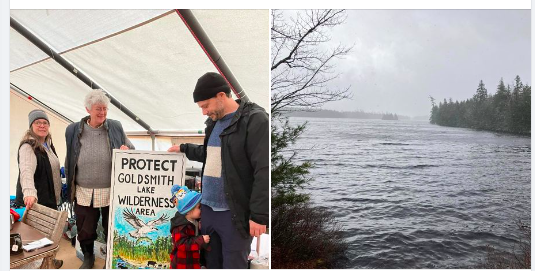 Has it really been three weeks since we set up our forest protection and education camp? We’ve had amazing visitors; civil conversations with WestFor, the local DNRR and the logging contractor; lots of successful forays searching for species at risk. The forest where logging was imminent is still standing. Support for protecting the Goldsmith Lake and Beal’s Brook Wilderness Areas is growing by the day.
Has it really been three weeks since we set up our forest protection and education camp? We’ve had amazing visitors; civil conversations with WestFor, the local DNRR and the logging contractor; lots of successful forays searching for species at risk. The forest where logging was imminent is still standing. Support for protecting the Goldsmith Lake and Beal’s Brook Wilderness Areas is growing by the day.
Yesterday municipal councillor Brad Redden and his son stopped in for a visit. Conversation included the impact that logging this area would have on the watershed. The spot where camp
is set up is not just in an area approved for Commercial Thinning which would remove 50% of the forest, it is also an area identified by DNRR as a potential site for clearcutting and spraying (optimistically known as ‘High Production Forestry.’) We need to protect forests on the South Mountain for biodiversity and carbon storage, yes, but also because they soak up water, hold it, gently release it. A heavy rainstorm when it hits clearcuts and extraction trails pours off the mountain, silting streams, flooding driveways and washing out culverts. Who pays for that damage? Not WestFor.
While conversation followed these lines, the ginger cookies donated to camp after the last SOOF Soup Sunday were greatly enjoyed by the younger generation…
Chilly days call for soup and carbs and we had both.
From Post on Friends of Goldsmith Lake Wilderness Area, Mar 21, 2024
Lichen Camp Day 20
 Yesterday was another great day for lichen hunters. Our numbers are growing — both the number of hunters and the number of species at risk lichen occurrences.
Yesterday was another great day for lichen hunters. Our numbers are growing — both the number of hunters and the number of species at risk lichen occurrences.
We added four more (pending confirmation) Frosted Glass Whiskers yesterday in a part of a cutblock we hadn’t visited before!
The survey we carried out last year of all sorts of species of stubble lichens in the area west of Goldsmith Lake indicated that this is an area of remarkable ecological continuity. We found other very rare species of stubble lichens beside the Frosted Glass Whiskers, species typically found in late successional (aka very old) forests, including one never found before in Nova Scotia. DNRR has read the scientific paper some of the citizen scientists wrote about that survey. The paper has been reviewed and recommended for publication by Troy McMullin, lichenologist at the Canadian Museum of Science.
What is it going to take to convince DNRR that they should put a hold on all the harvest plans approved for Goldsmith Lake West and Harris Brook (their name for the cutblocks on the east side of Goldsmith)? We are not going to stop looking and it seems likely we will keep finding. Isn’t this getting silly? Surely DNRR is embarrassed enough that they did not identify a single species at risk in any of the cutblocks they approved for logging around Goldsmith Lake?
We need interim protection for areas proposed for protection. Log first, protect later is not acceptable.

 From Post on Friends of Goldsmith Lake Wilderness Area, Mar 20, 2024
From Post on Friends of Goldsmith Lake Wilderness Area, Mar 20, 2024
Lichen Camp Day 19
There is joy in working together to protect somewhere and something you care about. Whether it is eating delicious lasagna in a warm tent with friends or hiking through swamps in search of species at risk, the shared goal adds to the pleasure. Put another way, it helps with the despair and outrage many of us feel as violence, greed, indifference tear our beautiful world apart.
So we add another black ash to the map and three more Frosted Glass Whiskers (pending confirmation), plan another foray today, discuss what it will take to convince DNRR they really should let go of the idea of logging here. How much evidence do they need that this is a unique and ecologically valuable area that should be protected? You just don’t find this kind of concentration of Frosted Glass Whiskers. We only ever found one at Last Hope/Beals Brook for example. These lichens are quite specific as to habitat.
By the same token the Lichen that saved the cutblock by Beal’s Brook from logging, the Black Foam lichen (Anzia colpodes), has not showed up at all in our lichen searches around Goldsmith Lake
From Post on Friends of Goldsmith Lake Wilderness Area, Mar 18, 2024
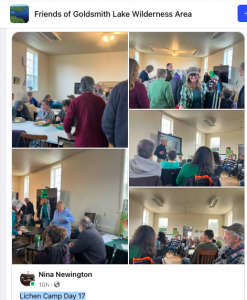 Lichen Camp Day 17
Lichen Camp Day 17
Some campers came down from the mountain for soup and learning — green learning that is for St. Pattie’s day. Beef vegetable soup (thank you Rob Bright) and Thai peanut (thanks Crystal Veinot) plus delicious brown bread donated by Bee’s Knees. The sweet treats table groaned with goodies people brought. Camping is good for the appetite but there was more than enough to go around for all the people who piled into the Centerlea Community Hall.
And then there were fungi. Retired professor Keith Eggers’ talk took us below the forest floor into the amazing interdependent world of trees and fungi. Some of the figures are staggering. Fossils from 420 million years ago show threads of fungi present inside the root cells of plants. Plants as they moved from ocean to land were already relying on fungi, fungi helping plants to gather nutrients from the soil while benefiting from the carbohydrates the plants photosynthesize. 92% of all plants depend on partnerships with assorted fungi. 75% of all plants rely on just 250 species of fungi, including our beloved chanterelles. (Oh, back to food again…)
There are a few freeloaders (here’s looking at you Ghost Pipes) but mostly cooperation and mutual benefit rule the day.
Thank you SOOF for the third great Soupy Sunday.
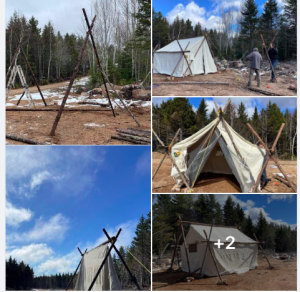 From Post on Friends of Goldsmith Lake Wilderness Area, Mar 17, 2024
From Post on Friends of Goldsmith Lake Wilderness Area, Mar 17, 2024
Nina Newington
Lichen Camp Day 16
Research and education, conversation and companionship, all are improved by shelter and warmth. Many thanks to the tent raising crew and some background help from YouTube. It’s an amazing old-timey structure and makes perfect sense in a windy spot like the head of this logging road. But it has to be said that viewing “How to raise a tent for elk and mule deer hunting” saved a lot of experimentation.
From Post on Friends of Goldsmith Lake Wilderness Area, Mar 16, 2024:
Lichen Camp Day 15
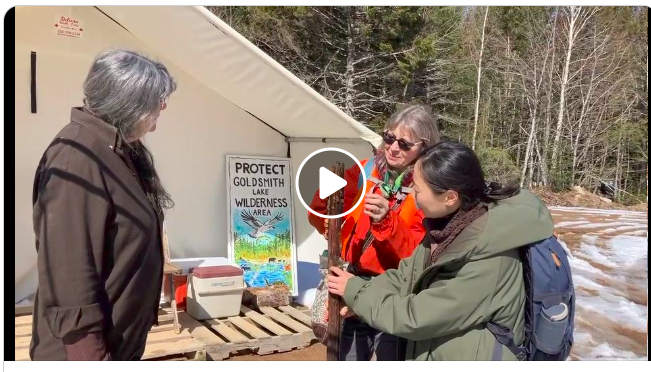 There’s so much to learn about the diversity of life in our forests. Here’s @LisaProulx talking about the glow in the dark fungus she spotted growing on a stick while we were lichen hunting. The Latin name is Panellus stipticus — Luminescent Panellus or Bitter Oyster are common names on iNaturalist.
There’s so much to learn about the diversity of life in our forests. Here’s @LisaProulx talking about the glow in the dark fungus she spotted growing on a stick while we were lichen hunting. The Latin name is Panellus stipticus — Luminescent Panellus or Bitter Oyster are common names on iNaturalist.
From Post on Friends of Goldsmith Lake Wilderness Area, Mar 15, 2024:
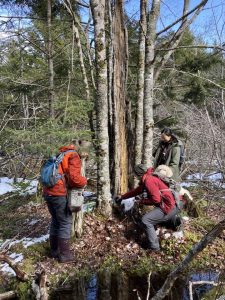 Lichen Camp Day 14
Lichen Camp Day 14
A great day, yesterday. The sun shone, snow melted, we found another Frosted Glass Whiskers lichen (pending confirmation) in the forest near camp as well as all manner of other wonders. Glow in the dark fungus anyone? More from Lisa Proulx on bioluminescence in another post.
From Post on Friends of Goldsmith Lake Wilderness Area, Mar 14, 2024:
Should be nice weather for a little light lichen hunting today. Nothing like the foray on March 2nd which yielded 3 new possible species at risk Frosted Glass Whiskers lichens in and around a cutblock where neither we nor the lichenologist WestFor hired had found any.
It generally takes a lot of person hours in the woods to find just one cluster of these pin-sized lichens, if you find them at all. They need a long time in old undisturbed forest to establish themselves. And then, if you do find some, because you can’t tell with just a hand lense whether you have found the protected Sclerophora peronella or her unprotected cousin S. amabilis, you take a very small sample, get it to an expert and wait for microscopic confirmation.
Occasionally, because you only take a tiny sample, the sample is insufficient and you need to go back and collect a better one. That’s what happened with one occurrence first identified in 2023. We collected a new sample on March 3rd.
It’s a careful, time consuming process. You want to have the least possible impact on the lichens and at the same time, this is the work that will protect them from the feller buncher crunching through the forest where they live.
The ‘harvest prescriptions’ approved by DNRR for the cutblocks where we continue to find the Frosted Glass Whiskers all involve removing at least 50% of the forest. Without our work, this amazing habitat would already have suffered far worse disturbance than the 30m wide clearcut WestFor made through these forests in the summer of 2022 to put in their new logging road.
So – drum roll please — all four of the March 2nd and 3rd specimens have been confirmed as the species at risk Frosted Glass Whiskers. With two out of three finds from February 25th also confirmed, that puts the total number of species at risk occurrences identified in the proposed Goldsmith Lake Wilderness Area at 40! Plus one still awaiting confirmation…
This is truly extraordinary, especially when you learn that the Minister of Natural Resources and Renewables is still peddling WestFor’s line that the Goldsmith Lake Wilderness Area has already been cut over and is not worth protecting.
Forty SAR occurrences, 33 of them an old growth forest indicator species, are not enough, it seems, to convince DNRR to give the whole area interim protection while final decisions are made about areas that will be given permanent protection to meet the 20% goal. Individual buffers are not enough when you find this many occurrences in one area. You need to protect the whole habitat. Guess we’ll just have to keep looking…
From Post on Friends of Goldsmith Lake Wilderness Area Mar 13, 2024
Lichen Camp Day 12 — Drinking that first wonderful cup of coffee, wild geese flew over the big tent, calling. However often I hear it, it stirs me. The calls keep the flock connected. Not unlike these little posts on Facebook?! There’s an analogy I never thought I’d make. But out at camp in unexpected snow, the little likes and hearts and hugs and comments do connect us all. Attention might be the scarcest resource and we choose to spend some of it on each other, the people who care for the forests and all our relations, human and nonhuman. Welalin.
 From Post on Friends of Goldsmith Lake Wilderness Area Mar 12, 2024
From Post on Friends of Goldsmith Lake Wilderness Area Mar 12, 2024
So this is what is happening out at the Goldsmith Lake Wilderness Area (proposed) A small group of Citizen Scientists have been diligently looking since early 2022 for this tiny stubble lichen that is so special it is supposed to be protected. And we are finding it! This document says Frosted glass Whiskers is difficult to find and that is right.
But if you understand their habitat needs you know where to look in the nooks and crannies of big old Red Maple or Yellow Birch trees’ exposed heartwood. We have found 6 new locations in the last couple of weeks alone.
And yet, DNRR has lifted the holds that had been placed on these cutblocks about a year ago, so that contractors can start logging. They are only required to leave a 100 meter buffer around each lichen, instead of protecting the entire habitat.
Check out the provincial regulations here: https://novascotia.ca/natr/wildlife/habitats/terrestrial/pdf/SMP_BFL_At-Risk-Lichens.pdf
 Lichen Camp Day 11. (Mar 11, 2024)
Lichen Camp Day 11. (Mar 11, 2024)
Spirits are good on a snowy day on the South Mountain. No snow in the Valley, we hear. Warm tent, interesting conversation reading the Province’s ‘At-Risk Lichens — Special Management Practices’ document (2018). The « Rare and sensitive » lichen we have found in several different parts of the proposed Goldsmith Lake Wilderness Area, the Frosted Glass-whiskers or Sclerophora peronella, « is very habitat specific, associated with very old forest.» When one of us gets home we’ll post the whole entry. It makes the case perfectly for why a place where this lichen has been found in unusual numbers should be protected.
Instead DNRR appears to have decided to ignore its own document and lift the holds on logging around Goldsmith. Rather than protecting the whole habitat, they want to chop it up, leaving only individual buffers around each of the occurrences of this species at risk.
Which part of their own statement don’t they get: « Many of the rare species of lichen in Nova Scotia require stable, moist conditions, combined with air quality that is relatively free of contaminants. Consequently, any land use activity that significantly alters the micro climate surrounding a forest lichen can pose a threat to that lichen’s long-term survival.”
Such as removing 50% or more of the forest — which is what every single one of the supposedly ecological harvest prescriptions approved for the area calls for? Does DNRR seriously believe this is the way to « prioritize biodiversity on crown land »?
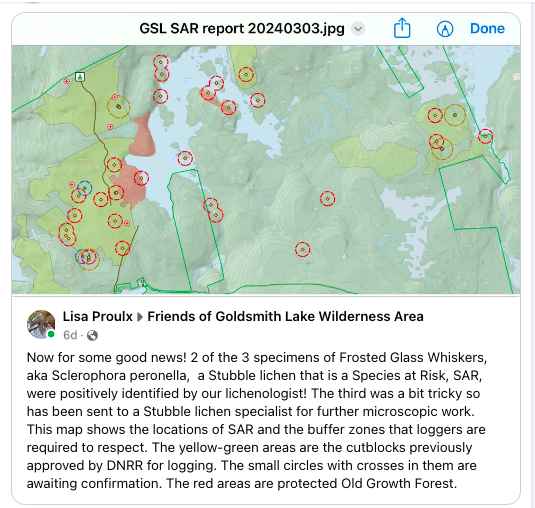
From Friends of Goldsmith Lake Wilderness Area, Mar 7, 2024
From Friends of Goldsmith Lake Wilderness Area, Mar 5, 2024
Join Friends of Goldsmith Lake Wilderness Area to keep an eye on the happenings at Goldsmith Lake, NS…. a beautiful forest full of biodiversity and species at risk.
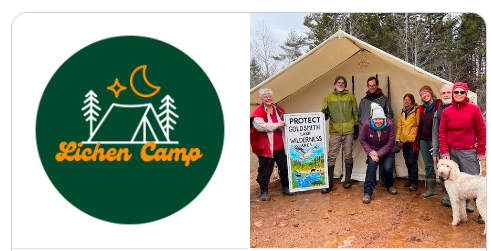
Lisa ProulxFriends of Goldsmith Lake Wilderness Area
·
What is Lichen Camp ?
Lichen Camp is a forest protection and education camp dedicated to educating the public and the government about biodiversity and the importance of protecting it. The specific focus is protecting the proposed Goldsmith Lake Wilderness Area. The camp came together when it became clear that the Department of Natural Resources and Renewables had removed the holds on extensive harvest plans in the area and that logging was imminent.
In 2022, Citizen Scientists of Southwest Nova proposed this 3900 hectare area of forests, wetlands and lakes to the Minister of Environment for protection as the Goldsmith Lake Wilderness Area. They have been exploring the area ever since, discovering old growth forests and species at risk. By March 2023 they had identified 17 species at risk occurrences, almost all lichens and almost all in cutblocks previously approved for harvesting. To their credit, DNRR put holds on all the cutblocks touched by species at risk occurrences. By the beginning of March 2024, the citizen scientists had doubled the number of species at risk occurrences they had identified within the proposed wilderness area. They also discovered that the holds had been lifted and that DNRR was allowing logging to proceed in all but “portions” of the cutblocks.
Lichen Camp is asking the government to extend immediate interim protection to the proposed Goldsmith Lake Wilderness Area while final decisions are made as to which 300,000 hectares will be conserved in order to meet the target of protecting 20% of Nova Scotia by 2030.
In the meantime, Lichen Camp will serve as a base for workshops and guided hikes, teaching people about lichens, species at risk and the importance of old forests. With a pristine lake and old growth forest nearby, Lichen Camp is a great starting point for people to see for themselves why the Goldsmith Lake Wilderness Area needs to be protected in perpetuity, for humans and for all our non-human kin.




